April 7, 2006
Air Date: April 7, 2006
FULL SHOW
SEGMENTS
Feel the Heat
/ Bruce GellermanView the page for this story
California is leading the state and local level charge against global warming with proposed legislation to cap greenhouse gas emissions. With the Bush administration unwilling to impose carbon limits, Living on Earth’s Bruce Gellerman takes a look at who's filling the federal government's regulatory shoes. (05:00)
The Liberal Republican
/ Jeff YoungView the page for this story
Rhode Island Republican Senator Lincoln Chafee has bucked his own party and President Bush to protect the Clean Air and Endangered Species Acts. So now conservative groups are backing Chafee's challenger in the Republican primary. Living on Earth’s Washington correspondent Jeff Young reports on whether moderate Republicans like Chafee are becoming rare political animals. (07:00)
Bridging the Straits of Messina
/ Ken ShulmanView the page for this story
The narrow sea passage between the island of Sicily and mainland Italy is a busy crossing for commuters and local merchants, as well as an important channel for bird, fish, and sea mammal migrations. Plans for a bridge across the Straits of Messina has environmentalists and many residents up in arms, while supporters see the bridge as vital to the region’s economic future. Ken Shulman reports. (09:30)
Treetop Adventures
View the page for this story
Professor Meg Lowman has studied insect plant relationships in rainforest canopies all over the world. So when she became a mom, there was really no question that her two sons would join her, becoming her best research assistants. Lowman and her son James tell host Steve Curwood about home life high above ground. (08:30)
Early Signs: Melting Ice Caps in Ecuador
View the page for this story
This week we travel to the Ecuadorean Andes, to a snow-covered mountain that has been the source of legend for centuries. Now the glacier has melted, and the region's native people try to cope with a warmer, drier, world. (15:25)
This week's EarthEar selection
listen /
download
A shepherd moves his flock along the hillsides of Tuscany.
Show Credits and Funders
Show Transcript
HOST: Steve Curwood
GUESTS: Margret Lowman, James Burgess
REPORTERS: Bruce Gellerman, Jeff Young, Ken Shulman, Pauline Bartalone
[THEME MUSIC]
CURWOOD: From NPR, this is Living on Earth.
CURWOOD: I’m Steve Curwood. With the federal government refusing to impose limits on global warming gases, states are leading the way. As usual, California is out in front with legislation to place mandatory caps on emissions.
PAVLEY: Those are the two magic words, and how we get there, of course, will be the subject of a lot of discussion.
CURWOOD: Also, home schooling is nothing new, but when your scientist mom turns rainforest treetops into your classrooms, do you miss what other kids get--proms and playing soccer?
BURGESS: Well, you know, maybe a little jealous sometimes. But I felt like we might have come out with the better end of the deal.
LOWMAN: But James, you had a blowgun, remember?
BURGESS: I did have a blowgun, yeah. You can pick up a lot of girls with a blow gun.
LOWMAN: You never told me these stories. (Laughs)
CURWOOD: That’s right, it’s canopy confessions, this week on Living on Earth. So stick around.
[NPR NEWSCAST]
ANNOUNCER: Support for Living on Earth comes from the National Science Foundation and Stonyfield Farm.
[THEME MUSIC]
Feel the Heat
CURWOOD: From the Jennifer and Ted Stanley Studios in Somerville, Massachusetts, this is Living on Earth. I’m Steve Curwood.
You've no doubt seen the slogan on a bumper sticker: “Think Globally, Act Locally.” Well, this week, that theme was underscored on the subject of curbing gases that cause global warming. States and cities are taking the leadership role, while in Washington it’s still talk but little action. Living on Earth’s Bruce Gellerman reports.
GELLERMAN: Last June, in the middle of what turned out to be the second hottest year on record, California Governor Arnold Schwarzenegger announced that his state – the 12th largest emitter of greenhouse gases – could no longer wait for Washington to combat climate change.
SCHWARZENEGGER: I say the debate is over. We know the signs, we see the threat, and we know the time for action is now.
GELLERMAN: Schwarzenegger signed an executive order creating the state's Climate Action Team, directing it to come up with strategies to dramatically cut California's emission of greenhouse gases. And this week, it did. The Action Team handed the governor a 1,300 page report. In it more than 50 recommendations, including strategies to boost renewable energy supplies, create emission credits, and, more controversial, impose a cap on industrial greenhouse gases and require companies to report their emissions.
The day the Action report was released, California Assemblywoman Fran Pavley introduced a bill that would put teeth in the recommendations.
PAVLEY: Primarily what the bill will do is begin a mandatory reporting of greenhouse gas emissions so we can establish a baseline, and then we’d put a cap on those emissions.
GELLERMAN: Well, you’ve said the two magic words: “mandatory” and “cap.”
PAVLEY: Those are the two magic words, and how we get there, of course, will be the subject of a lot of discussion.
GELLERMAN: The discussions begin in earnest on April 11th, when Governor Schwarzenegger convenes a Summit on Climate Change in San Francisco. And in the coming weeks he'll travel around the state to see how cities and counties can do more to curb greenhouse emissions.
Lawmaker Fran Pavley says he’ll find that local governments are already leading the way.
PAVLEY: There’s a county in California called Sonoma County. All ten cities in Sonoma County have adopted targets to reduce greenhouse gas emissions, and 47 of their 50 local elected officials have signed on to this. So we’re seeing cities really being very, very creative and doing their fair share to reduce greenhouse gas emissions.
GELLERMAN: California's actions stand in stark contrast to President Bush's view on climate change and greenhouse emissions. In his most recent public remarks about global warming, the president reiterated his belief that mandates and caps aren't the way to go.
BUSH: I believe the best way to put technologies in place that will not only achieve national objectives like less addiction to oil but also help clean the air, is to be wealthy enough to invest in technologies.
GELLERMAN: The president says mandates and caps would cause massive layoffs. But according to a new study from the University of California-Berkeley, cutting emissions to the levels targeted by Governor Schwarzenegger will boost the state's economy by $60 billion and create 20,000 new jobs by 2020.
And it's not just California that’s feeling, and reacting, to the heat.
CHAVEZ: This is an incredibly important issue and, of course, America’s mayors are beginning to lead the way.
GELLERMAN: Martin Chavez, mayor of Albuquerque, New Mexico, was among local officials and environmentalists attending a press conference this past week in advance of a workshop in
Washington convened by the Senate Energy Committee. Local officials urged senators to take immediate action. But while federal officials are talking the talk, mayors like Chavez are walking the walk – and driving cleaner cars.
CHAVEZ: At least half of our fleet is now alternative vehicles, and I’ve issued an executive
order: we will no longer purchase any vehicles in the fleet that are not alternative fuel.
GELLERMAN: Last year, the U.S. Senate passed a non-binding resolution calling for action to curb climate changing gases. New Mexico's Republican Senator Pete Domenici, chairman of the Energy Committee, championed the bill. And this week, Domenici lead the senate workshop where 29 experts from energy corporations, businesses and environmental groups testified about ways to cut greenhouse gases. Conspicuously absent were any representatives from the auto industry. Also absent, at least in Senator Domenici's mind, is the chance that Congress and the president will pass legislation this year limiting greenhouse gas emissions.
DOMENICI: Designing and implementing a mandatory system will be very difficult, both politically and economically. But I also feel now, as I did then, that we need to start somewhere. We need to start somewhere, and this conference is our starting point.
GELLERMAN: Critics say time is running out, and when all is said and done in Washington about climate change, they charge that more is said than done. Here's California Assemblywoman Fran Pavley.
PAVLEY: The federal role right now has been missing in action, and we need the federal government to step up to the plate.
GELLERMAN: What are you looking for the feds to do? What’s their role?
PAVLEY: Right now it would be just, get out of our way. (Laughs)
GELLERMAN: For Living on Earth, I'm Bruce Gellerman.
Related links:
- California Climate Action Team
- Assembly Bill 32 – California Climate Act of 2006
- University of California – Berkeley study: “Managing Greenhouse Gas Emissions in California”
[MUSIC: M. Jarvis & A. Jarvis “Rice Leaves” from ‘Gold Leaf Branches (Disc 2)’ (Gold Leaf - 2005)
The Liberal Republican
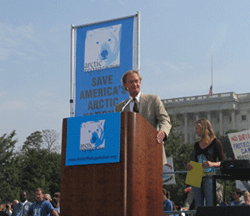
Senator Chafee speaks out against drilling in the Arctic National Wildlife Refuge.
CURWOOD: Senator Lincoln Chafee, the mild-mannered moderate from Rhode Island, has quietly compiled one of the strongest pro-environment records in the Republican Party. He’s for action on climate change and against drilling in the Arctic Refuge – votes that put him out of step with President Bush, and have earned him some enemies in his own party. Conservative activists support the opponent to Senator Chafee in the upcoming Rhode Island Republican primary, a close contest that could end Lincoln Chafee’s political career. Living on Earth’s Jeff Young reports.
[SENATE HALL AMBIENT SOUND]
YOUNG: Jennifer Hughes Martini teaches ecology at Brown University. She recently took a break from the classroom to visit Congress.
MARTIN: I’m on Capitol Hill to help deliver a letter from 5,700 scientists that are very concerned about the Endangered Species Act.
YOUNG: Martini and her fellow scientists are concerned about a dramatic overhaul of the Endangered Species Act narrowly passed by the House of Representatives. The scientists say the bill would hinder their role in protecting species, and they want the Senate to stop it. Martini is counting on her home state Senator Lincoln Chafee.

Senator Chafee speaks out against drilling in the Arctic National Wildlife Refuge.
YOUNG: While many of his Republican colleagues are eager to re-write the Act, Chafee has instead taken a slow, deliberate approach, with numerous hearings to decide what, if any, changes to make.
CHAFEE: I was surprised at the lack of anger and vociferous outrage at the Endangered Species Act from what I heard. So I think the Act is performing better over time and there might not be a need, a great need, for any kind of drastic reform.
YOUNG: Chafee appears unlikely to let a bill radically reforming the Act to pass. It’s familiar territory for Chafee, whose spot on the environment committee often makes him the decisive vote on important bills on clean air, water and energy.
CHAFEE: Without my vote it’s a tie and fails, so I’m a critical vote. That’s what happened with clean air, Clear Skies legislation. It happened with the refinery bill and now has the potential on Endangered Species. Many of these are, I argue, Republican initiatives. Endangered Species passed President Nixon, so I argue that our legacy as Republicans is for a strong environmental movement.
YOUNG: Chafee’s supporters applaud his stand to uphold the landmark law on endangered species. David Jenkins is with a group called Republicans for Environmental Protection.
JENKINS: Senator Chafee is in a unique position to try to stop this bad thing from coming over and getting passed by the senate as well. So if he can block that, that’s great. It’s a wonderful victory for the environment and everybody who cares about it.
YOUNG: But Jenkins’ group is a minority within a party dominated by conservatives eager to rewrite environmental law. That could make Chafee himself a bit of an endangered species. Moderate Republicans once roamed the GOP landscape. But these days they are rare political animals, and sometimes in the sights of conservatives gunning for their seats.
KNIGHT: I would say I would rather see anybody but Chafee in that chair.
YOUNG: That’s Peyton Knight with the National Center for Public Policy Research, a group affiliated with the conservative Heritage Foundation.
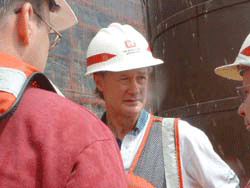
Senator Lincoln Chafee tours the site of a Rhode Island dredging project.
YOUNG: It’s not just Chafee’s environment votes that have conservatives upset. Chafee voted against the war in Iraq and the president’s tax cuts. And he opposed confirmation of Judge Sam Alito to the Supreme Court. Conservative bloggers are slamming Chafee as a traitor to the party who fails to support the president.
But Scott McKay, a veteran political reporter for the Providence Journal, says Chafee is well-adapted to his political habitat in Rhode Island – a state that votes overwhelmingly for Democrats.
MCKAY: In general, in Rhode Island a lot of the positions that Senator Chafee espouses are in sync with what Rhode Islanders feel, but not necessarily in sync with those of his own party. In other words, we’re talking about a navy blue state here, a state that basically went for Kerry and a state that historically has only elected since the Great Depression two Republicans to the United States Senate, and both of their names were Chafee.
YOUNG: Lincoln Chafee took the senate seat his late father once held. Both found success with moderate policies and strong environmental protection that appeal to Independents. Nearly half Rhode Island’s registered voters are Independents. But Mckay says Chafee is now vulnerable to a challenge from his right in the Republican primary election in September.
Cranston Mayor Steve Laffey offers what he calls a real conservative alternative to the moderate Chafee. Laffey’s picking up serious financial support from conservative groups like the Club for Growth, which claims it has rounded up $300,000 in campaign donations for Laffey. Reporter McKay says Chafee could be in trouble.
MCKAY: I think every liberal Republican these days, every liberal to moderate Republican, is an endangered species. We don’t have those kind of politicians anymore. There are really very few of them, and Chafee is one of the few of these, what the conservative base calls “RINOS.”
YOUNG: “RINO” – it’s a slur of an acronym tossed around by conservative critics. Chafee says he’s heard it a lot lately.
CHAFEE: Sure, of course, RINO – Republican in name only, R-I-N-O. But I make my arguments and that’s my challenge, make my arguments right back. All my so-called traitorous votes: the Iraq war. Well, how are we doing in Iraq right now? How much is it costing us? Were there weapons of mass destruction? On the tax cuts, are you happy with our deficits? Clear Skies. You don’t think we want clean air for our children and grandchildren? And global warming and recognizing that human activity might be causing this climate change. Don’t you think we ought to be doing something? So, that’s my challenge, to make these arguments to my fellow Republicans which I’m willing to do.
YOUNG: Chafee’s environmental supporters wonder if they will keep a key conservation vote in the senate, or if that rare political animal, the moderate Republican, will be one step closer to extinction. For Living on Earth, I’m Jeff Young in Washington.
Related link:
Senator Lincoln Chafee’s homepage
CURWOOD: Coming up: thinking big – some say too big – about connecting Sicily to the rest of Italy with a bridge. Stay tuned to Living on Earth.
[MUSIC: Thomas Wydler & Toby Dammit “The Great Lie” from ‘Morphosa Harmonia’ (Hit Thing Germany – 2004)]
Bridging the Straits of Messina
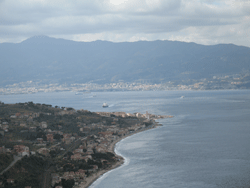
Ferries travel between Messina, Sicily and Villa San Giovanni, Calabria every 15 minutes. (Photo: Ken Shulman)
CURWOOD: It’s Living on Earth. I’m Steve Curwood. As voters in Italy elect their new parliament, a controversial public works project hangs in the balance: a proposed bridge across the Straits of Messina that would connect the island of Sicily with southern Italy. Incumbent Prime Minister Silvio Berlusconi supports the project, which would open Sicily as a major port. His opponent Romano Prodi opposes it. So do many ecologists and geologists who are concerned about the earthquake history of the region, as well as the fragile Mediterranean ecosystem. Ken Shulman has our report.
[GANGPLANK, FERRY SOUNDS]

Ferries travel between Messina, Sicily and Villa San Giovanni, Calabria every 15 minutes. (Photo: Ken Shulman)
[TRUCK OF CHICKENS]
SHULMAN: But the proposed bridge across the Straits of Messina is not intended for these commuters. Nor is it intended for local merchants, like this Sicilian chicken farmer waiting to truck his fowl to market.
Lorenzo Falciai is spokesperson for Stretto di Messina SPA, the company that handles the business end of the bridge project.
FALCIAI [SPEAKS IN ITALIAN] [VOICEOVER]: Marine traffic in the region is growing by double digits every year. Trade with Asia is growing exponentially, and this trade is exploding across the Mediterranean. As a nation, we have to put Sicily and Calabria in a condition where they can intercept this traffic.
SHULMAN: The bridge across the Straits of Messina is intended to provide a stable rail and automobile link between Sicily and mainland Italy and Europe, completing the so-called Berlin-Palermo land corridor. It’s a strategic gamble and, perhaps, a necessary one. Sicily and Calabria suffer from endemic unemployment and underdevelopment. There is no high-speed rail line, and few highways worthy of the name. Falciai believes the bridge will be an economic catalyst.
FALCIAI: [VOICEOVER] It’s not like Sicily and Calabria are deserts and the bridge is the magic wand that will transform these deserts into gardens. The bridge is one piece in the mosaic. And a big one. That’s why it must be one of the first works undertaken. And I hope that by 2012, or by 2015, when the bridge will be completed, the other infrastructure elements will be completed as well.
[SEA SOUNDS]
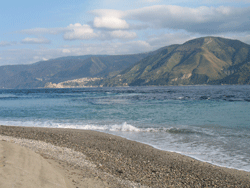
The dark, cold waters of the Ionian Sea meet the light, cool waters of the Tyrenian, forming whirlpools and riptides. (Photo: Ken Shulman)
[CAR SOUNDS]
SHULMAN: Emilio De Domenico is a professor of oceanography at the University of Messina. He fears that the fine particles, dust, and runoff from the predicted 350 million square feet of excavation necessary to build the bridge will suffocate the marine invertebrates and phytoplankton, both prime links of the Strait’s food chain. De Domenico lives in Ganzirri, the zone where much of the bridge work will take place. If construction begins by the end of the year, as the company hopes, De Domenico will have to move. Yet it’s not because of his house, the professor claims, that he’s against the bridge.
DOMENICO: [VOICEOVER] I’m against it because it’s already a dinosaur. A showpiece that will be completely useless, that will not improve the economy, that we aren’t even sure can be built, but that we are sure will destroy one of the most beautiful areas in all of the Mediterranean.
[TRUCKS UNLOADING]
SHULMAN: Except for a few busy weeks in summer, it’s only a ten minute wait and a 20 minute ferry ride from Messina to Villa San Giovanni. This small Calabrian town is the northern end of the proposed bridge, and site of one of the structure’s two mammoth 1,253-foot towers – towers taller than the Eiffel Tower. The two massive suspension cables that will support the two-mile-long deck will also be anchored here, and on the hills above Ganzirri on the Sicilian side.
[CLIMBING SOUNDS]
SHULMAN: The Straits of Messina run between two tectonic plates, the plates between the African and European landmasses. Earthquakes are frequent here, including major ones like the shock that leveled the city of Messina in 1908. Ferdinando Jovine is a geologist living in Villa San Giovanni. He believes the two plates are moving apart.
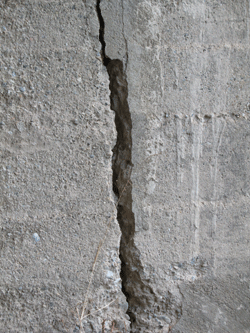
This crack formed in a 10 year old highway column on the Calabrian side, a few feet from the site of the proposed bridge tower. (Photo: Ken Shulman)
SHULMAN: The researchers at Stretto di Messina don’t share Jovine’s conclusions. Enzo Vullo is chief engineer at the Rome-based company. He says that because of its mass and flexibility, a suspension bridge has the best chance of any structure of surviving a major earthquake. He also disputes Jovine’s other data.
VULLO: [VOICEOVER] There is a movement of the soil, but it doesn’t involve the bedrock beneath, which is where we will anchor the towers and cables. And the two coasts aren’t pulling apart; they’re actually rotating in unison. But even if it were true, we’re talking about a millimeter or two per year, or 16 inches over the next 200 years. The bridge will expand three times that distance in summer with the heat.
[CHURCH BELLS]
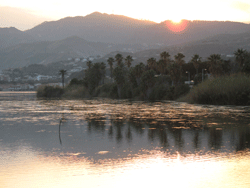
One of two brackish water lakes just north of Messina, Sicily. They host hundreds of fish and bird species, and offer food and rest to migratory birds. (Photo: Ken Shulman)
One of the environmentalists’ greatest fears is that the proposed bridge will be yet another abandoned public works project, leaving behind only an irreversible ecological disaster. Stretto di Messina officials say this is unlikely. As a publicly owned company, they say, they have a responsibility to their shareholders and investors to finish the job, and on time.
[CAR DRIVING BY]
SHULMAN: Lago di Faro is one of two brackish water lakes in Ganzirri. The lakes are connected by short canals to the sea, and serve as nursery and refuge for countless species of birds and fish. Until recently, poachers used to drive to the lakeside, step out of their cars, and shoot egrets, herons, and migratory falcons who’d stop at the lake for a final meal before flying across the Strait. If you drive there today, the birds will flee as soon as you turn off your motor.
[SHELLFISH SORTING]
SHULMAN: Pippo Donato owns a shellfish farm and processing plant on the lake. Like many locals, he was initially in favor of the bridge. But, like many locals, he’s changed his position – even though his business stands to benefit.
DONATO: [VOICEOVER] My opinion started to change after my son was born. I started to think about those who would live here after I’m gone. And I think that it is our duty to leave behind this landscape, as it is, intact.
SHULMAN: Not all locals along the Strait are against the project. Emma D’Agostino runs a bar in downtown Messina, near the city hall. She tells her clients that the bridge will be a shot in the arm for Messina, which is badly in need of one.
D’AGOSTINO: [VOICEOVER] Right now nobody stops in Messina. They all go on to other places. The bridge will create jobs, and it will bring us tourists. Buses. Trains. These people will use our hotels, our restaurants. We’ll be able to eat again.
SHULMAN: The people who support the bridge say they speak for Sicily’s future. Those against the bridge claim to speak for the future, as well. But it’s a different future, a future where Sicily builds roads, railroads, and hotels, and uses its unparalleled archaeology, beaches, and climate to develop an economy based on sustainable agriculture and eco-tourism. At stake is a spectacular piece of land, steeped in history and myth, but mired in corruption, and mismanagement.
For Living on Earth, I’m Ken Shulman, in Messina, Italy.
Related link:
Stretto di Messina’s website
[SEA SOUNDS]
[MUSIC: Anouar Brahem Trio “Vague” from ‘Le Voyage de Sahar’ (ECM – 2006)]
Treetop Adventures
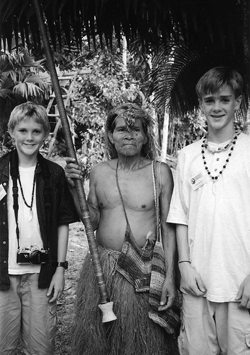
Eddie and James trade for blowguns in the Amazon. (Photo: Margaret Lowman)
CURWOOD: When biologist Meg Lowman would welcome her two sons home after school, they didn’t get the usual peanut butter and jelly sandwich, a glass of milk, and a chat around the kitchen table. And her boys didn’t sit around watching TV or playing video games. No, James and Eddie spent their younger days helping their mom research the interactions between plants and insects in rainforest canopies from the Pacific Northwest to Cameroon.
Margaret Lowman and her younger son, James, have come down from great heights to talk about their newest book: “It's a Jungle Up There: More Tales from the Treetops.” Hello, Professor Lowman.
LOWMAN: Hey, hello.
CURWOOD: And James Burgess is her son. Hello.
BURGESS: Hello.
CURWOOD: Welcome to Living on Earth. Now, you’ve lived in rainforest canopies all over the world, right?
LOWMAN: That’s correct. I suppose as a young mom my biggest dilemma was should I leave the kids at the bottom of the tree with all the poisonous snakes, or take them into the canopy which seemed a little dangerous. But they did like to climb, so we went from Australia to Panama and Peru, and they did in the end become my best research assistants ever.

Eddie and James trade for blowguns in the Amazon. (Photo: Margaret Lowman)
BURGESS: Well, a lot of times we would maybe get up before the bust of dawn so we could get out. And usually most of the birds are around in the rainforest before the sun comes up. But we would eventually make our way up to the tops of the trees, and maybe look for insects or birds, or maybe just leaves that had been chewed on by animals, for most of the day, maybe into the night.
CURWOOD: Now, what about spending the night in the canopy itself?
LOWMAN: Oohh, well that’s extra fun. And believe it or not, my work, which specializes in insects and plants, requires a lot of night work because most insects seem to prefer to feed at night. Because then they can avoid being eaten by the birds of the daytime. So we did spend a lot of time up in walkways and tree platforms at night. And the sounds are just amazing – all the bugs are munching at once, and it really can get quite noisy up there.
CURWOOD: Okay. Now what’s the advantage for a plant biologist and entomologist – that is, someone who studies insects – to take two young boys with her into the rainforest?
LOWMAN: Most of my colleagues would probably tell me there’s no advantage to having children in the forest. In fact, they would look askance when I explained to them what I was doing sometimes. But in the end there were lots of great advantages, and that’s partly why I wrote about it.
For one, having a family in other countries and other cultures is a really wonderful, precious communication mode. And I did find in most other cultures they value family so highly that they were always full of trust and enthusiasm and kindness when they knew that I had brought my kids along.
And secondly, the boys really do have better senses than us older people, so they could see things and hear things, and it provided me, essentially, with three man-hours of work for every one woman-hour out in the field. So in a funny way I probably got to see and measure more things than perhaps some of my counterparts.
CURWOOD: Now, James, what’s it like growing up with a scientist mom?
BURGESS: Well, it has some pros and cons, I guess. It was really great, you know, to be able to go to these exotic places and come back with exciting stories to tell all our friends. At the same time, it might have been rough sometimes, especially when we were much younger, sometimes she would go away by herself and we would be at home with the babysitter or grandparents or something. We had some interesting experiences. Just to be around dozens and dozens of other scientists all excitedly discussing the newest variety of mite that lives under someone’s armpit or something.
LOWMAN: (Laughs)
CURWOOD: (Laughs)
BURGESS: It was always interesting to see how other scientists interacted. It maybe showed us what the world of science was really like.
LOWMAN: And James, didn’t you love all those insect recipes?
BURGESS: Oh, absolutely. Yeah, we got a good key into the world of entomophagy, which is eating insects.
CURWOOD: How about butter worms? You go for those? Or are you into like those really crunchy beetles?
BURGESS: Oh. Well, you know, there’s always the honey-seared tarantulas. A classic, I think. There’s just an incredible variety, actually, of recipes for different insects and other arthropods.
CURWOOD: So, I mean, how jealous did you feel of kids that had, what, you know, cars, television, rock and roll, electric guitars?
BURGESS: Well, you know, maybe a little jealous sometimes. But I felt like we might have come out with the better end of the deal.
LOWMAN: But James, you had a blowgun, remember?
BURGESS: I did have a blowgun. (Laughs) You can pick up a lot of girls with a blowgun. (Laughs)
CURWOOD: (Laughs)
LOWMAN: (Laughs) You never told me these stories.
CURWOOD: You’re not supposed to hear them, Mom. (Laughs) Hey, tell me about some of the scary moments you had with your kids there.
LOWMAN: The scary moments? For me, the scary moments might be different than they felt for Eddie or James. But one moment was flying in a very flimsy old plane in the very mountainous parts of Belize. As a matter of fact, we heard six months after our trip that the pilot and some other scientists were actually killed slamming into a cliff edge. So the use of technology in tropical areas can sometimes leave moms a little bit nervous. And after that, not too much worried me. To be honest, I’m much more worried when my kids tell me they’re going to New York City on the subway then when we would spend months at a time working and living in the Amazon. So I guess that’s just my funny bias.
CURWOOD: Now James, as I understand it you have continued this line of research even without going with mom now to the rainforests because, what, you’re off in college now at Princeton. What kind of things are you doing on your own?
BURGESS: Well, I have been to Antarctica recently, and when I was there I was actually looking for some microorganisms that live in mosses and lichens. And hopefully, if I get a chance, I’ll be able to do some more research along this line looking for other microorganisms, perhaps in the Arctic, as well. And who knows where else.
CURWOOD: So Professor Lowman, you’ve got a problem.
LOWMAN: I do?
CURWOOD: You’ve lost your two big-time assistants.
LOWMAN: I have a problem, you’re absolutely right. And that is a real shame. In fact, writing the book was perhaps the last hurrah, a project we could share together. But I’m looking forward to becoming their research assistants now, with Eddie majoring in environmental chemistry and James, hopefully, going off somewhere in the tropics with his good knowledge of Spanish and engineering. Perhaps I can help them carry the screwdriver or the hammer or something.
CURWOOD: And if they have children is it going to be granny and the kids in the treetops?
BURGESS: (Laughs)
LOWMAN: I think so. I’m not rushing them by any means, but someday I hope to train a few more young naturalists. And, in fact, that’s one thing the boys really did for me, is get my research passion kind of misdirected or newly-aligned to become a person who does a lot of science education. I’ve become really fascinated with the problem of science literacy, and through the boys’ eyes I now try hard to think of ways that I can involve youth education in all of my research.
CURWOOD: Margaret Lowman is a professor of biology and environmental studies at the New College of Florida. Her son, James Burgess, is a freshman at Princeton University. And their new book is called “It's a Jungle Up There: More Tales from the Treetops.” Margaret and James, thanks so much for sharing your stories.
BURGESS: Thanks so much for having us.
LOWMAN: Thank you. I hope you’ll come up to the canopy some time.
Related links:
- “It’s a Jungle Up There”
- Margaret Lowman’s website
[MUSIC: Laura Veirs “Ether Sings” from ‘Carbon Glacier’ (Nonesuch – 2004)]
CURWOOD: Just ahead: the disappearing snows near the equator. Keep listening to Living on Earth.
ANNOUNCER: Support for NPR comes from NPR stations, and Kashi, maker of all natural foods. Founded on the belief that everyone has the power to make healthful changes. Kashi. Seven whole grains on a mission; The Kresge Foundation, investing in nonprofits to help them catalyze growth, connect to stakeholders, and challenge greater support. On the web at Kresge dot org; The Annenberg Fund for excellence in communications and education; The W-K Kellogg Foundation. From Vision to Innovative Impact: 75 Years of Philanthropy.' This is NPR. National Public Radio.
[MUSIC: The Shadows “Apache” from ‘Scamp: Your Passport to Excitement’ (Scamp Records - 1994)]
Early Signs: Melting Ice Caps in Ecuador
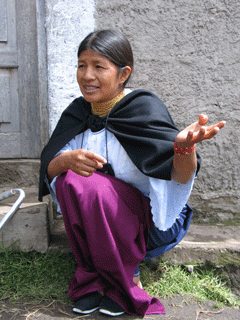
Rosita Ramos tells stories about the Cotacachi mountain. (Photo: Pauline Bartolone)
CURWOOD: It’s Living on Earth. I’m Steve Curwood. Sometime in the last five years, the glacier atop a mountain in northern Ecuador vanished. It might seem paradoxical to have glaciers right at the equator, but the high altitude of the Andes Mountains has kept the peaks snowy year round for thousands of years – up until now.
Scientists say that 80 percent of Andean ice caps are likely to melt away in the next 15 years due to climate change. The glacier’s demise means less water and a changing way of life for the 30,000 mostly indigenous people who live in the foothills of Cotacachi Mountain. Their story is this week’s installment of our ongoing series, “Early Signs: Reports from a Warming Planet.”
The series is a collaboration of the UC-Berkeley Graduate School of Journalism, Salon dot com, and Living on Earth to document places around the world where concerns about climate change are already having an impact. Places like Cotacachi Mountain which was visited by producers Felicia Mello and Pauline Bartolone, who narrates our story.
[WOMAN SPEAKING SPANISH]

Rosita Ramos tells stories about the Cotacachi mountain. (Photo: Pauline Bartolone)
RAMOS: [VOICEOVER] For us, the mountain is not a volcano filled with lava or rocks. It’s full of grains and potatoes and all of the energy of the crops that we have here. We have a lot of contact with nature. Our parents always had a good communication with the land. And because of this communication they always had good harvests.
BARTOLONE: Wearing bright beaded jewelry, Rosita sits on a couch in the coolness of her simple concrete home. She has taken a break from the harsh midday sun that shines down on Cotacachi, a wide volcano rising to 16,000 feet, just 20 miles north of the equator.
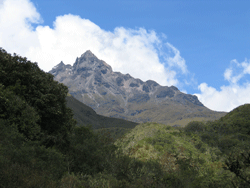
The Cotacachi volcano, which lost its permanent snow cap at the turn of the century. (Photo: Felicia Mello)
RAMOS: [VOICEOVER] I remember when I was little, I would see Cotacachi after a snowfall and she would be covered with snow. And now I see her with very little snow. We had a creek right down there, a little waterfall. That’s where we would get water to drink and to wash our clothes. That waterfall was big, but now it’s really small.
[WALKING]
BARTOLONE: Indigenous people have shared stories about the mountain for generations. Lately their tales seem to hint at troubling changes. Rosita gathers those tales. She takes us across mountain canyons to a nearby town, where Maria Perugache is sifting quinoa on a blue blanket in front of her mud home.
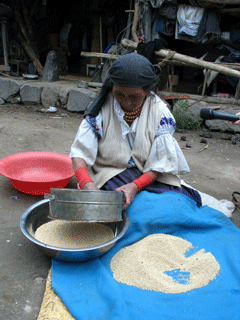
Maria Perugache sifting quinoa in front of her home at the base of Cotacachi volcano. (Photo: Pauline Bartolone)
BARTOLONE: The two women talk in their native Quichua. Behind them, the bare brown peak of Mama Cotacachi pierces the clouds. Cotacachi is married to a nearby volcano, Perugache tells Rosita, but it hasn’t been a happy match.
RAMOS: [VOICEOVER] She says, “When they argue the thunderbolts fall, boom, boom. And that startles us, and we say ‘oh my God, they are fighting.’ And that makes us laugh.”
[LAUGHING]
BARTOLONE: In the legend, Cotacachi’s husband Imbabura cheated on her with Cayambe, a snow-covered mountain to the south.
RAMOS: [VOICEOVER] He gave Cotacachi grain. But he gave Cayambe the rain, the water. That’s why on that side they have water, and Cotacachi is starved of water.
BARTOLONE: Not everyone in Cotacachi’s 43 mountain villages has heard the term “global warming.” But, according to scientists, that’s exactly what’s contributing to changes in their communities. Temperatures have gone up by nearly three degrees Fahrenheit in the Ecuadoran Andes in the past half century.
For glaciers in the tropics, that can spell the difference between stability and retreat. Since the ice cap on Cotacachi disappeared five years ago, residents have fought over scarce water resources. Farmers are losing crops because they have little water to irrigate. People in Rosita’s community can no longer depend on local creeks.
[FOOTFALLS]
BARTOLONE: When Cotacachi was covered with snow and ice, meltwater from the glacier rushed down this canyon, Chumavi Creek, filling a lagoon below. Now, except when it rains, the creek is nothing but a winding path of weeds and stones.
[WALKING]
ZAPATA: [VOICEOVER] Everything that you see that looks like sand, that’s where the glacier used to be.
BARTOLONE: We walk the creek with Xavier Zapata, a water resources engineer who has studied the mountain.
ZAPATA: [VOICEOVER] Chumavi had water all the time because it was fed by the glacier. It’s part of a glacier’s hydrological balance: snow accumulates, it compacts, ice forms. There is an input and an output. But with climate change, the temperature is rising in the country. It affects the glaciers and they retreat. We’re now definitely in a time when the glacier has disappeared and is no longer feeds the rivers.
[ROCK CLIMBING]
BARTOLONE: Chumavi isn’t the only creek with a problem. All over the mountain, says Zapata, rivers and streams are getting smaller.
ZAPATA: [VOICEOVER] The scary part is all these communities that you see get their water from the rivers. And when there isn’t any water in the rivers, I can’t imagine the disaster we would see.
[ANCHOR RELEASING. BOAT MOTOR. LAPPING WATER]
BARTOLONE: Halfway down the mountain, a crater holds a deep blue lagoon with two small islands at its center. Motorboats whiz by as tourists line up waiting to take a ride on the lagoon’s clear waters.
[SEVILLANO TAKING MONEY FROM CUSTOMERS]
BARTOLONE: Marcelo Sevillano has helped run a family boat tour business since he was a teenager.
[ANCHOR RELEASE. GUNNING MOTOR]
BARTOLONE: He fires up the motor and ferries a group of travelers toward one of the islands.
[BOAT SLOWING]
BARTOLONE: There he stops and tells a few chapters from his family’s collection of local folklore.
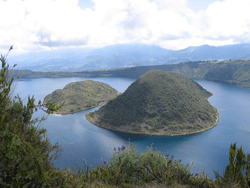
Laguna Cuicocha, a crater lake on the Cotacachi volcano. (Photo: Felicia Mello)
BARTOLONE: Sevillano worries that environmental changes are threatening the lagoon. Years ago, shamans would perform rituals at the base of a waterfall fed by Chumavi Creek. But today that waterfall is gone. And the lake, which once collected runoff from the glacier like a giant sink, is slowly being drained.
[WATER LAPPING]
BARTOLONE: Over the past decade, the water level in the stadium-sized lagoon has gone down over ten feet. Twice, the boat company has had to lower the dock to reach the receding tide.
SEVILLANO: [VOICEOVER] We are talking about a huge amount of water. It’s obviously a problem that worries us, but its not just here. This is at a global level. What’s influencing it is global warming. Cotacachi has no snow. It wasn’t like that 15-20 years ago.
[WATER]
BARTOLONE: Water from Laguna Cuicocha seeps through mountain crevices to springs farther down the mountain, where farmers use it to irrigate their crops.
At this large commercial farm, Hacienda La Maria, eucalyptus trees give shade to plots of organic vegetables, where women in head-scarves move quietly down the rows. A farm worker named Juan Espin shows us the reservoir that feeds these crops, a small pond covered with algae.
ESPIN: [VOICEOVER] The water always comes in here, and it is stored there, and then, when it’s necessary, we open the gates and irrigate.
BARTOLONE: The shrinking water supply has forced this farm to come up with new ways to manage water. But they still have only enough to plant half their land. Espin has lived in this highland community all his life, and says farming didn’t used to be so difficult.
ESPIN: The water has decreased tremendously. You used to have year-round springs. I’m from here in Imantag and I remember that the springs that we had here were abundant. They supplied the whole community. But five years ago, the water dried up.
BARTOLONE: With less water from the mountain, the hacienda is more dependent on the rain.
ESPIN: [VOICEOVER] Sometimes we have to play a guessing game – gee, is it going to rain or isn’t it? Should we plant or not? It’s a risk sometimes to plant because you don’t know if the rain is going to come.
BARTOLONE: So, both the rain and glacial runoff have become uncertain. Rain falls in strange patterns these days, and some residents say the seasons are playing with them. Scientists haven’t established the cause of these changes. But the complaints echo predictions of the world’s best-known climate authority, the Intergovernmental Panel on Climate Change, that global warming may bring more irregular weather to Latin America.
[RAKING SOUND]
BARTOLONE: The dry spells have affected villages farther down the mountain, like this one, where 73-year-old Segundo Alfredo Tabango is raking alfalfa.
TABANGO: [VOICEOVER] It’s been really hard for us for several years with the drought. When it doesn't rain, time passes and we can't plant. The summers have been very long. The plants, even the corn, they’re all dried up.
BARTOLONE: Tabango says diseases have struck his weakened plants. His father never used farm chemicals, but, Tabango says, now he has no choice.
TABANGO: [VOICEOVER] If you don’t spray right away, you lose the whole crop. We don’t know what else to do.
BARTOLONE: With an unpredictable rainy season, the land does not yield enough to support everyone. People are beginning to make different life plans. Tabango says his three sons choose to drive taxis in a nearby city. And Tabango says he and his wife now sometimes go hungry because when crops fail they have nothing to exchange for staples like salt, sugar, and rice.
TABANGO: [VOICEOVER] When there isn't money, you just have to do without. If you eat lunch, you don’t have dinner. If you have coffee, you don’t have lunch. Or if you have lunch, you have just coffee for your dinner, nothing else.
BARTOLONE: Drought hit hard throughout Ecuador last year, forcing the government to declare a state of emergency and import energy from longtime rival Peru. Production was down by a third at the nation’s largest hydroelectric plant, and, on the coast, desperate people dug their own wells to search for water.
Scientists say you can’t link a particular drought to global warming. But Julio Cornejo sees both the drought and glacial retreat as part of the same disturbing picture. He’s the chief of Ecuador’s new climate change program within its environmental ministry. He says the country must learn to manage its water better before it’s too late.
CORNEJO: [VOICEOVER] Global warming is not the fault of third-world countries. We are dancing at a party that we didn’t even want to attend. But we are beginning to change our habits anyways, and we’ll have to keep doing that. If we don’t, climate change will grab hold of us and we will disappear.
BARTOLONE: When she’s not working or taking care of her four children, Rosita Ramos visits neighbors and often hears their stories about Mama Cotacachi. She’s heard scientists talk about global warming, but Rosita has a different explanation for the changes in the mountain.
RAMOS: [VOICEOVER] For me it’s because people here no longer have the same respect as before. Before, we respected Mother Earth, the plants, the animals and all of nature. Picking a plant was something sacred. Tearing the earth to make an irrigation canal was like killing a person. But the young people don’t maintain the culture, not even my children! They go to work in the city and come back with other ideas. For them our stories are only fairy tales.
BARTOLONE: Toward the end of our time in Cotacachi, Rosita takes us to a nearby village to visit a yacha, a Quichua spiritual leader. His name is Don Jose Maria Montalvo, and he uses herbs and prayers to cure patients in the patio of his tile-roofed home.
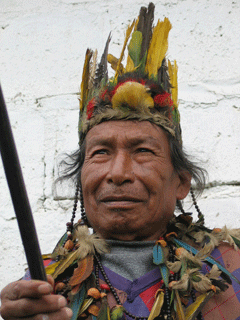
Shaman Jose Maria Montalvo in front of his home in Morales Chupa, Ecuador. (Photo: Pauline Bartolone)
BARTOLONE: He comes out to meet us in a tattered sweater and sweatpants, holding a glass ball that he says is made of ice from the mountain. The shaman’s eyes are tired. As Rosita translates, he says he draws his powers from Cotacachi. But lately, their relationship is changing.
[SHAMAN COUGHING]
RAMOS TRANSLATING MONTALVO: [VOICEOVER] Before, I could enter into the mountain, he says. She would come to me. But now it’s not the same. I can feel her energy pulling away. So I see that Cotacachi is different. I don’t know if other people see this, but I, who have worked with the mountains, this is what I see.
BARTOLONE: The shaman says the mountain is responding to changing cultural ways. In a dream, Cotacachi showed him that people were burning the grass on her slopes.
RAMOS TRANSLATING MONTALVO: [VOICEOVER] And Cotacachi said to him ‘I’m burnt, look how they have burned all my skirts.’ And since then he sees that the water is going away. The rain is decreasing. The weather also is changing. And finally he realized that his energy is disappearing, too.
BARTOLONE: The view from one small corner of the Andes, where memory stretches back a long way. But not long enough to remember a mountain with no snow.
[MUSIC: Inti Raymi (Unknown song/Unknown album)]
CURWOOD: Our story on Cotacachi Mountain was produced by Pauline Bartolone and Felicia Mello as part of our ongoing series “Early Signs: Reports from a Warming Planet.”
Next week, we go to the South Pacific to the island nation of Kiribati, where some residents say they’re already beginning to notice beach erosion and salty drinking water that scientists predict will only get worse as the sea level rises.
MAN: When their government looks ahead, say, 100 years, 200 years, you know, there’s a pretty good chance those islands won’t even exist.
CURWOOD: “Early Signs” is a collaboration of the UC-Berkeley Graduate School of Journalism, Salon dot com and Living on Earth. To see photos and read a print version of the story about Cotacachi Mountain, visit our website, Living on Earth dot org. That’s Living on Earth dot O-R-G.
 |
 |  |  |
Related link:
To see a print version of this story, and other reports in this series, click here
[FLUTE SOUNDS]
CURWOOD: We leave you this week on a mountain along Italy’s Tuscan coast.
[SOUNDS OF COWS AND BELLS]
CURWOOD: Near the village of Carrara, Steven Feld found a shepherd guiding his flock down marbled hillsides to the sound of bells from the village church.
EARTH EAR: “Gragnana, Italy” recorded by Steven Feld from The Time of Bells, Volume 1’ (VoxLox/EarthEar – 2004)
CURWOOD: Living on Earth is produced by the World Media Foundation. Our crew includes Ashley Ahearn, Chris Ballman, Eileen Bolinsky, Jennifer Chu, and Ingrid Lobet - with help from Christopher Bolick, Kelley Cronin, James Curwood and Michelle Kweder. Thanks this week to Eric Schwarzenbach and Sam Weinger. Our interns are Bobby Bascomb and Emily Taylor. Our technical director is Dennis Foley. Alison Dean composed our themes. You can find us at LOE dot org. I’m Steve Curwood. Thanks for listening.
ANNOUNCER: Funding for Living on Earth comes from the National Science Foundation, supporting coverage of emerging science; Kashi, maker of all-natural cereals and snacks for health and wellness. Kashi. Seven whole grains on a mission; and Stonyfield Farm. Organic yogurt, smoothies and milk. Ten percent of profits are donated to efforts that help protect and restore the earth. Details at Stonyfield dot com. Support also comes from NPR member stations, the Ford Foundation, the Welbourne Ecology and the Saunders Hotel Group of Boston's Lennox and Copley Square Hotels. Serving you and the environment while helping preserve the past and protect the future, 800-225-7676.
ANNOUNCER2: This is NPR, National Public Radio.
Living on Earth wants to hear from you!
Living on Earth
62 Calef Highway, Suite 212
Lee, NH 03861
Telephone: 617-287-4121
E-mail: comments@loe.org
Newsletter [Click here]
Donate to Living on Earth!
Living on Earth is an independent media program and relies entirely on contributions from listeners and institutions supporting public service. Please donate now to preserve an independent environmental voice.
NewsletterLiving on Earth offers a weekly delivery of the show's rundown to your mailbox. Sign up for our newsletter today!
 Sailors For The Sea: Be the change you want to sea.
Sailors For The Sea: Be the change you want to sea.
 The Grantham Foundation for the Protection of the Environment: Committed to protecting and improving the health of the global environment.
The Grantham Foundation for the Protection of the Environment: Committed to protecting and improving the health of the global environment.
 Contribute to Living on Earth and receive, as our gift to you, an archival print of one of Mark Seth Lender's extraordinary wildlife photographs. Follow the link to see Mark's current collection of photographs.
Contribute to Living on Earth and receive, as our gift to you, an archival print of one of Mark Seth Lender's extraordinary wildlife photographs. Follow the link to see Mark's current collection of photographs.
 Buy a signed copy of Mark Seth Lender's book Smeagull the Seagull & support Living on Earth
Buy a signed copy of Mark Seth Lender's book Smeagull the Seagull & support Living on Earth

